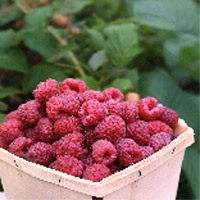Raspberry

Delicate raspberries are highly perishable and difficult to ship, making them an expensive treat if purchased at a grocery store. However, they are easy to grow in a home garden, providing abundant harvests of mouthwatering fruit in midsummer.
About This Plant
Select plants that are bare-root or rooted in soil. Buy only certified virus-free plants. Black raspberries are especially vulnerable to disease, so plant resistant varieties when possible. Summer-bearers should yield some berries in their second year and then full crops each succeeding summer. Everbearers may produce some fruit the first fall.
Site Selection
Select a site in full sun; avoid low-lying areas where frosty air will accumulate. Eliminate perennial weeds, preferably with a cover crop planted 1 year in advance. Destroy neighboring wild raspberries or blackberries to prevent disease from spreading to your plants.
Planting Instructions
Plant in late winter or early spring. Set plants in the garden an inch or two deeper than previously grown. Space plants 3 feet apart in rows 6 to 7 feet apart. Allow red and yellow raspberries to fill in a hedgerow not more than 2 feet wide (some purples will also create a hedgerow); blackcaps and most purples will remain as separate plants. Cut black raspberry canes back to ground level; leave an 8-inch handle on others. Water well.
Care
Keep the aisles between rows tilled bare or plant grass and keep it mowed. Cultivate to control weeds early the first summer, then mulch thickly. Once the plants are established, maintain a layer of mulch 4 to 8 inches deep year-round. Dig or till up suckers that spread beyond row boundaries. Erect a T-trellis if your canes don't stand up on their own. Different types of raspberries require different types of pruning. Contact your Cooperative Extension office for information on pruning, as well as on managing pests in your area, which may include cane borers, crown borer, and anthracnose disease.
Harvesting
Berries usually ripen over a period of 2 to 3 weeks during early summer; everbearers yield again for several weeks in early fall. When they slide easily off the small white core, berries are ripe. Pick into small containers so bottom berries are not crushed.






 Delicate raspberries are highly perishable and difficult to ship, making them an expensive treat if purchased at a grocery store. However, they are easy to grow in a home garden, providing abundant harvests of mouthwatering fruit in midsummer.
Delicate raspberries are highly perishable and difficult to ship, making them an expensive treat if purchased at a grocery store. However, they are easy to grow in a home garden, providing abundant harvests of mouthwatering fruit in midsummer.